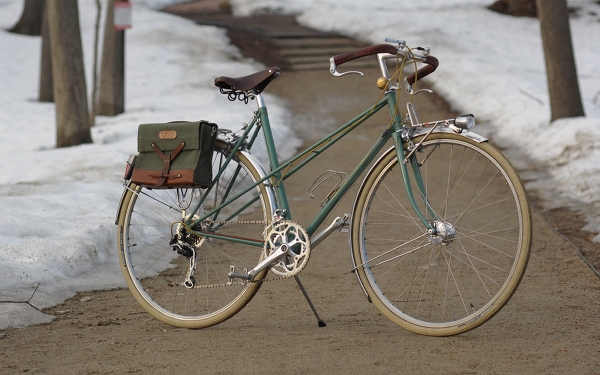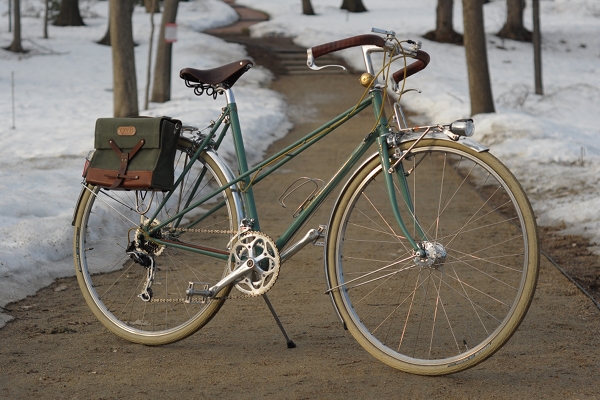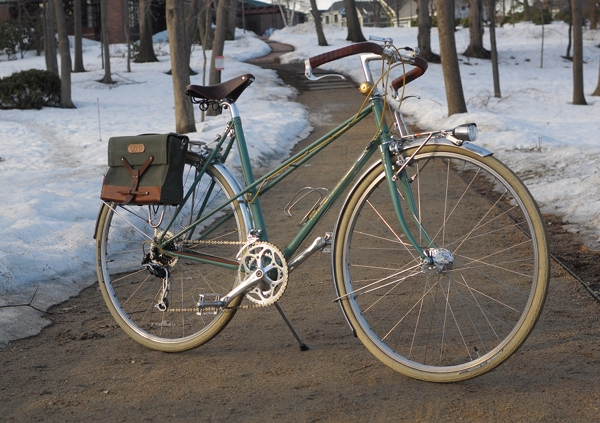I had three lenses with me in the camera bag yesterday, so I thought it would be neat to illustrate how different lenses affect the way a bicycle looks in pictures. Here are three photos of my mixte standing in the same position, taken with (left to right:) an 85mm lens, a 50mm lens, and a 35mm lens, using identical camera settings. Notice any differences?
Here is a closer look at the picture taken with the 85mm lens. First off, notice the relationship of the bicycle to the trees: In this picture the bike looks like it is positioned in between the trees. There are hardly any trees in the frame itself and if I wanted to I could crop them out all together, making the bike an isolated object in the midst of snow and sand. There is also not a great deal of background information in the space above the bike: a few stairs, but that is all. Furthermore, the things in the background are kind of blurry in comparison to how sharp the bicycle itself looks. And finally, take a look at the size of the bicycle's wheels. The bike is slightly turned toward the camera and the front wheel is closer to me than the rear. But despite this, the front wheel does not look much larger than the rear; the bicycle looks proportional. The 85mm lens is considered a "portrait lens" precisely because it creates these effects: It isolates the subject from the clutter of surrounding objects and reduces unflattering foreshortening effects in the subject's face and body.
Now the same scene, but taken with a 50mm lens. Notice how much more background information is visible in this picture. And it's impossible to crop out, because all that extra stuff is directly behind the bike, rather than around it. The same trees that were spread out to the right and left in the previous picture, now overlap with the bike's wheels and can't be cropped out. More stuff in the space above the bike is visible as well - now we see not just the stairs, but a winding path. And the background scenery is in sharper focus than in the previous picture. It's a nice composition as far as narrative goes (we get more of a sense of the bicycle being in the woods), but a portrait or product photographer would tell you that the background is starting to compete with the subject of the photo. One of the trees looks like it's growing out of the pannier, and the winding path draws the eye away from the forms of the bike itself.
And same scene once again, but with a 35mm lens. The entire patch of woods and the street behind it have now been wrangled into the shot. The background scenery is just as sharp as the bicycle itself, and there's so much of it, that the scene looks altogether cluttered. Also, notice that the front wheel of the bicycle looks considerably larger than the rear, as a result of being closer to the camera. Foreshortening effects are pretty strong with this lens: If I were photographing a person's face, their nose would appear exaggeratedly large in comparison to their eyes for the same reason as the mixte's wheels look to be different sizes.
There is much more to be said about differences between these lenses, and in fact I haven't given a proper introduction to camera lenses at all - but that would take ages and it's nothing you can't find in an online reference. Hopefully, these pictures illustrate the way in which lenses play a role in bicycle photography, and why sometimes it seems like you just can't compose the shot you want with your camera. For those of you who use digital SLRs with interchangeable lenses, which do you prefer to use for bicycle photos?
Saturday, February 19, 2011
Subscribe to:
Post Comments (Atom)
Blog Archive
-
▼
2011
(631)
-
▼
February
(79)
- Readers' Choice Poll
- Bicycle Shopping: What Do We Expect?
- Moultons, Modern and Vintage
- c1926 Big Four Nortons
- No title
- What about a Ferrari FF for $5,700
- No Car, Must Travel
- On Handmade Bicycle Shows
- Hand Brazing a Bicycle Frame
- First vs Second Winter of Cycling
- Sent by Yoshikazu in east Japan."This Norton belon...
- Budget Roadbike for a Novice? Help a Sister Out!
- Lug Samesies! Vintage Bianchi vs Trek
- Right Up Front
- Choosing Your Gospel: Rivendell vs Bicycle Quarterly
- Malcolm's 1929 Model 19 Norton
- 2010 Triumph Bonneville T100 – Classic Modern Moto...
- Modern motorcycle for 2010 Yamaha custom V4 Engine
- New Online Ducati Hangout!
- Tricks of the Camera
- The Pashley Princess: a Retrospective from a Forme...
- 1929 Model 18 Norton
- Manufacturers with 'History': Does Continuity Matter?
- GMC Truck Review
- Land Rover Exhibits Its Greenest Models Ever At Th...
- Is the Wheel Lock a Useful Feature?
- Tesla Motors Reports Fourth Quarter and Full Year ...
- Small garbage Compactor
- Insinkerator garbage disposer
- Misadventures in the Thaw
- Valentine and Anti-Valentine Give-Aways
- A Question of Favourites
- Two Wheeled Riding Withdrawals
- Hats Off!
- 1937 Model 20 Norton
- Should I Care About Cadence?
- 2011 Honda CBR250RR rendering
- Getting to Know You
- When Does a Customer Turn Designer?
- Gears anyone?
- Step-Throughs: an Advantage in Traffic?
- Remembering a Man I Never Knew
- 2005 Kawasaki Z750S: MD First Ride
- Round Tasmania on a 1926 Model 18 Norton.
- Turn Signals and Brake Lights: Can It Be Done, Ele...
- Spare Parts Order
- A Monday Cocktail and a Cat in a Hat
- Suzuki GSX-R750 2011
- New Kawasaki-Z1000
- 2011 Yamaha V-Star
- HONDA VFR1200F V-4 motorcycle technology
- Yamaha Star 250 Review 2011
- DUCATI ANNOUNCES 848
- Ducati Monster 696
- Kawasaki Ninja 650R Edition 2011
- Honda CBR1000RR 2011
- 2011 New Ducati Monster
- New Honda CBR250R 2011
- Honda CBR Design
- Bimota DB7 Magazine Motorcycle
- Yamaha YZF R1 Red
- Yamaha YZF R1 RedYamaha YZF R1 RedYamaha YZF R1 ...
- motorcycle ridley
- Yamaha YZF R1 RedYamaha YZF R1 RedYamaha YZF R1 ...
- Skinny, Wide, or Stay the Heck Inside?
- 1927 rear carrier
- When a Bike Is Not for You, What to Do?
- 1912 Big Four Norton
- Cycling Indoors: the Kurt Kinetic Trainer
- Gears anyone?
- Cycling and Statistics
- Modifikasi Yamaha Mio Sporty vs Mio Soul
- 2010 Suzuki GSX-R600 Limited Edition Reviews
- 2010-2011 Price List Of Suzuki Cars Update
- Ducati Monster 1100 Porn
- Hammarhead Industries Jack Pine Motorcycle
- A pretty blonde girl seated on a modern motorcycle
- The 'Lady's Bicycle': Descriptive, Offensive, or M...
- Martin's fun day out
-
▼
February
(79)





0 comments:
Post a Comment